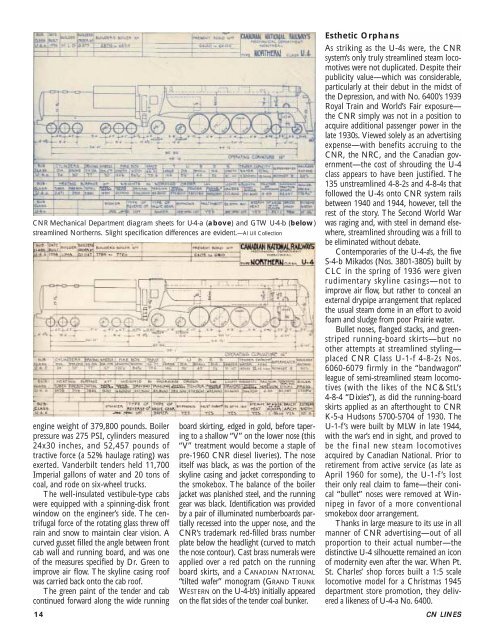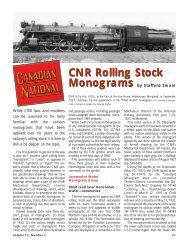CN LINES V12N3 - Canadian National Railways Historical Association
CN LINES V12N3 - Canadian National Railways Historical Association
CN LINES V12N3 - Canadian National Railways Historical Association
You also want an ePaper? Increase the reach of your titles
YUMPU automatically turns print PDFs into web optimized ePapers that Google loves.
<strong>CN</strong>R Mechanical Department diagram sheets for U-4-a (above) and GTW U-4-b (below)<br />
streamlined Northerns. Slight specification differences are evident.—Al Lill Collection<br />
engine weight of 379,800 pounds. Boiler<br />
pressure was 275 PSI, cylinders measured<br />
24x30 inches, and 52,457 pounds of<br />
tractive force (a 52% haulage rating) was<br />
exerted. Vanderbilt tenders held 11,700<br />
Imperial gallons of water and 20 tons of<br />
coal, and rode on six-wheel trucks.<br />
The well-insulated vestibule-type cabs<br />
were equipped with a spinning-disk front<br />
window on the engineer’s side. The centrifugal<br />
force of the rotating glass threw off<br />
rain and snow to maintain clear vision. A<br />
curved gusset filled the angle between front<br />
cab wall and running board, and was one<br />
of the measures specified by Dr. Green to<br />
improve air flow. The skyline casing roof<br />
was carried back onto the cab roof.<br />
The green paint of the tender and cab<br />
continued forward along the wide running<br />
board skirting, edged in gold, before tapering<br />
to a shallow “V” on the lower nose (this<br />
“V” treatment would become a staple of<br />
pre-1960 <strong>CN</strong>R diesel liveries). The nose<br />
itself was black, as was the portion of the<br />
skyline casing and jacket corresponding to<br />
the smokebox. The balance of the boiler<br />
jacket was planished steel, and the running<br />
gear was black. Identification was provided<br />
by a pair of illuminated numberboards partially<br />
recessed into the upper nose, and the<br />
<strong>CN</strong>R’s trademark red-filled brass number<br />
plate below the headlight (curved to match<br />
the nose contour). Cast brass numerals were<br />
applied over a red patch on the running<br />
board skirts, and a CANADIAN NATIONAL<br />
“tilted wafer” monogram (GRAND TRUNK<br />
WESTERN on the U-4-b’s) initially appeared<br />
on the flat sides of the tender coal bunker.<br />
Esthetic Orphans<br />
As striking as the U-4s were, the <strong>CN</strong>R<br />
system’s only truly streamlined steam locomotives<br />
were not duplicated. Despite their<br />
publicity value—which was considerable,<br />
particularly at their debut in the midst of<br />
the Depression, and with No. 6400’s 1939<br />
Royal Train and World’s Fair exposure—<br />
the <strong>CN</strong>R simply was not in a position to<br />
acquire additional passenger power in the<br />
late 1930s. Viewed solely as an advertising<br />
expense—with benefits accruing to the<br />
<strong>CN</strong>R, the NRC, and the <strong>Canadian</strong> government—the<br />
cost of shrouding the U-4<br />
class appears to have been justified. The<br />
135 unstreamlined 4-8-2s and 4-8-4s that<br />
followed the U-4s onto <strong>CN</strong>R system rails<br />
between 1940 and 1944, however, tell the<br />
rest of the story. The Second World War<br />
was raging and, with steel in demand elsewhere,<br />
streamlined shrouding was a frill to<br />
be eliminated without debate.<br />
Contemporaries of the U-4-a’s, the five<br />
S-4-b Mikados (Nos. 3801-3805) built by<br />
CLC in the spring of 1936 were given<br />
rudimentary skyline casings—not to<br />
improve air flow, but rather to conceal an<br />
external drypipe arrangement that replaced<br />
the usual steam dome in an effort to avoid<br />
foam and sludge from poor Prairie water.<br />
Bullet noses, flanged stacks, and greenstriped<br />
running-board skirts—but no<br />
other attempts at streamlined styling—<br />
placed <strong>CN</strong>R Class U-1-f 4-8-2s Nos.<br />
6060-6079 firmly in the “bandwagon”<br />
league of semi-streamlined steam locomotives<br />
(with the likes of the NC&StL’s<br />
4-8-4 “Dixies”), as did the running-board<br />
skirts applied as an afterthought to <strong>CN</strong>R<br />
K-5-a Hudsons 5700-5704 of 1930. The<br />
U-1-f’s were built by MLW in late 1944,<br />
with the war’s end in sight, and proved to<br />
be the final new steam locomotives<br />
acquired by <strong>Canadian</strong> <strong>National</strong>. Prior to<br />
retirement from active service (as late as<br />
April 1960 for some), the U-1-f’s lost<br />
their only real claim to fame—their conical<br />
“bullet” noses were removed at Winnipeg<br />
in favor of a more conventional<br />
smokebox door arrangement.<br />
Thanks in large measure to its use in all<br />
manner of <strong>CN</strong>R advertising—out of all<br />
proportion to their actual number—the<br />
distinctive U-4 silhouette remained an icon<br />
of modernity even after the war. When Pt.<br />
St. Charles’ shop forces built a 1:5 scale<br />
locomotive model for a Christmas 1945<br />
department store promotion, they delivered<br />
a likeness of U-4-a No. 6400.<br />
14 <strong>CN</strong> <strong>LINES</strong>



